The Promise of Television
ERIK BORN
Which came first—cinema or television?[1] Until recently, the origins of moving images were usually taken to be synonymous with those of “the movies,” and the year 1895 was commonly considered the annus mirabilis in the history of cinema. Despite some dissenting work on the development of moving images over the millennia,[2] the date remained significant in mainstream film studies for marking at least three decisive conditions of possibility for the appearance of the medium: the availability of the cinematograph; the genesis of production and exhibition practice; and the emergence of aesthetic considerations. In television studies, on the other hand, there was never a similar consensus. Over two decades before the consolidation of cinema, there were already models for televisual machines, and the earliest patent for a mechanical television system, which looms especially large over the German historiography of television, was granted a decade prior to the first patents for cinematographic devices. Nevertheless, the promise of electronic television would remain unfulfilled throughout the anni horribiles of two world wars, an extended incubation period representing a long-standing source of irritation for media studies. As the editors of a recent collection on German Television observe, “Until the mid-twentieth century, television remained only an epistemic object, not fully realized and thus partly latent in the history of media.”[3] By extension, one of the editors wonders, “Might television be a latency or blind spot of media theory?”[4]
Television studies are confronted not only with the notorious difficulty of putting theory into practice, which doubtless contributed to the latency of the medium, but also with the even more sizeable challenge of putting practice into theory, of coming to terms with the long-standing critical backlash against the “idiot box.” Long seen as anathema to intellectual discourse, especially in the wake of Neil Postman’s Amusing Ourselves to Death, the medium of television has been the subject of much productive theorization in recent years, not only in terms of the kinds of knowledge television produces but also in terms of the embodied knowledge required for its seemingly simple operation.[5] Just as the answer to the chronological question no longer appears to be self-evident, thanks to over three decades of revisionist historiography, there is no longer a definitive answer to the ontological question of television. Against the common definition of television as a domestic live medium, studies of television continue to reveal the medium’s complexity and heterogeneity.[6] Whether in our current situation of Television after TV or the historical formation of Television before TV, to borrow the titles of two recent books, the essence of television may only be found, somewhat paradoxically, in its susceptibility to change. Against the common assumption that the success of a medium depends on its stabilization, moreover, the history of television, as one of “constant transformation,”[7] suggests a different framework for media studies, more in line with that adopted in The Promise of Cinema.
Like the promise of cinema, the promise of television speaks to “the modern period’s expanding chasm between the ‘space of experience’ and the ‘horizon of expectation’.”[8] To borrow the subtitle of a seminal article on early German television, “the slow development of a fast medium” was an experience of constant delays, of something always on the horizon.[9] Unlike the cinema, however, the increasing discrepancy between experience and expectation may seem to have created a situation where competing media thwarted the development of television, which was never able to pin down its own identity. However, if change is the only constant in the history of television, then the medium can be better understood as an “experimental system,” a concept from science and technology studies referring to the mutual interaction of objects, theories, and practices in the production of knowledge.[10] From this perspective, constant transformation and not eventual institutionalization is what ultimately accounts for a system’s efficiency. The experimental nature of television and its instable position between media can help explain its subsequent endurance and ongoing attraction, insofar as television remains an inherently experimental medium, largely removed from the teleology of media history.[11]
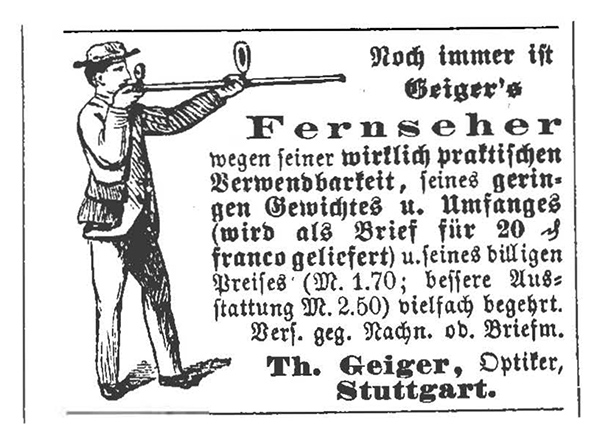
An advertisement for a “television,” an optical device that uses two lenses to magnify images at a distance, i.e. a telescope. Source: Illustrirte Zeitung (1884), repr. in Geiger, Fernsehen, 16.
Adopting a long view of television, distant vision emerges as either a red thread or a red herring. “Seeing into the distance is an ancient wish attested to frequently in stories and fairy tales,” observes Knut Hickethier at the start of his now-standard Geschichte des Deutschen Fernsehens.[12] While the origins of a desire for moving images are commonly traced back, at least in apparatus theory, to the Allegory of the Cave in Plato’s Republic, the media topoi of television are distributed across more heterogeneous allegories of seeing at a distance, usually concerning magic mirrors, looking glasses, and fantastical surfaces capable of monitoring everything imaginable. Until the end of the nineteenth century, the German word for a television, Fernseher, still referred to the telescope, and the master patent for television, effectively a mechanical scanner that could analyze an image into pixels, was filed by Paul Nipkow under the rubric of an “Elektrisches Teleskop.”[13] Around 1900, the German word for watching television, fernsehen, referred to the ability to see things at a distance in the sense of both remote viewing practices and psychic visions of the future, an indication of an alliance between occultism and technology that would remain prominent throughout the interwar period.[14] Over the course of the long nineteenth century, an entire televisual paradigm emerged through the discursive construction of the desired medium as a “window to the world.”[15] Disseminated in the popular press, the discourse of television came to signify immediacy, simultaneity, and ubiquity—what we might now call the possibility of telepresence. In the absence of a human body, the televisual machines present in its place were supposed to create a sense of real-time participation in remote events.[16] From this perspective, the history of television may seem one of instrumentalization, the mobilization of technology in service of the “extensions of man.”
Against the backdrop of this well-developed televisual imaginary, the brief section on television in Friedrich Kittler’s Optical Media must sound absurd. “Unlike film, there were no dreams of television prior to its development,” the media philosopher claims, in typical apodictic fashion, about the differentiation of media systems in modernity. “Television was and is not a desire of so-called humans, but rather it is largely a civilian byproduct of military electronics.”[17] While commonly dismissed as part of his Teutonic military complex, Kittler’s brief comments on television culminate in a productive distinction between symbolic, alphabetic, inscription-based media, on the one hand, and non-symbolic, non-alphabetic, signal-based media, on the other. Television, for Kittler, signals the decisive rupture in the history of optical media. “In contrast to film, television was already no longer optics,” Kittler claims, thereby subverting the common classification of film and television as visual media. While we are able “to hold a film reel up to the sun and see what every frame shows,” we are able only “to intercept television signals, but not to look at them, because they only exist as electronic signals.” In other words, television—at least, electronic television—eludes the visual imaginary, since “the eyes can only access these signals at the beginning and end of the transmission chain, in the studio and on the screen.”[18] To put it less polemically, I would suggest that if human beings are unable to see television per se, other media are tasked with making it visible, another reminder of the constitution of television as an experimental system.
Television was hardly a foregone conclusion during the period examined in the sourcebook, and is better understood as part of an ongoing process of differentiation. For some readers, the inclusion of four texts explicitly about television in a sourcebook on German film theory, S. E. Bastian’s “The Telefilm” (#266), Arthur Korn’s “Why We Still Do Not Have Television” (#270), Ernst Steffen’s “Telecinema in the Home” (#273), and Rudolf Arnheim’s “Radio-Film” (#276), might come as a surprise. However, the careful juxtaposition of sources on film and television reflects the extent to which the promises of these two media were just as intertwined in their early days as they remain today. During the decades covered in the sourcebook, there were a variety of German terms for television beyond Fernsehen, including Fernkino, Funkkino, Telefotografie, and Radiokinematografie. Each of these compounds associated the promise of television with an existing medium, whether film, radio, or photography, which should call further into question assumptions about media specificity as well as the televisual paradigm of immediacy. While most people seemed to know that they wanted television, hardly anybody agreed on what they wanted television for, and the fields for its most common predicted applications ranged from the police and the military, through meteorology and medicine, to illustrated magazines and the cinema.[19]
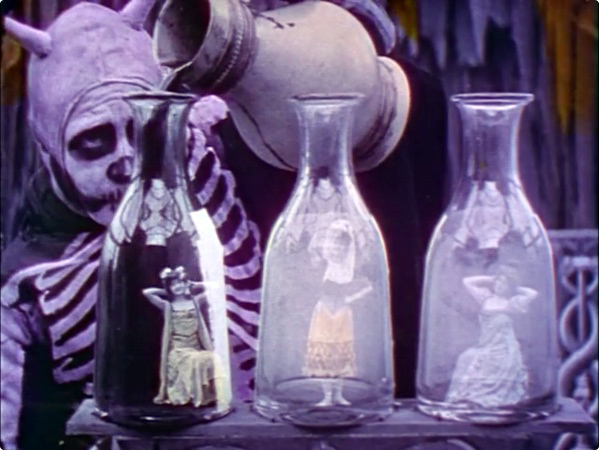
The visualization of telepresence in Segundo de Chomón’s Le spectre rouge (The Red Specter, 1907).
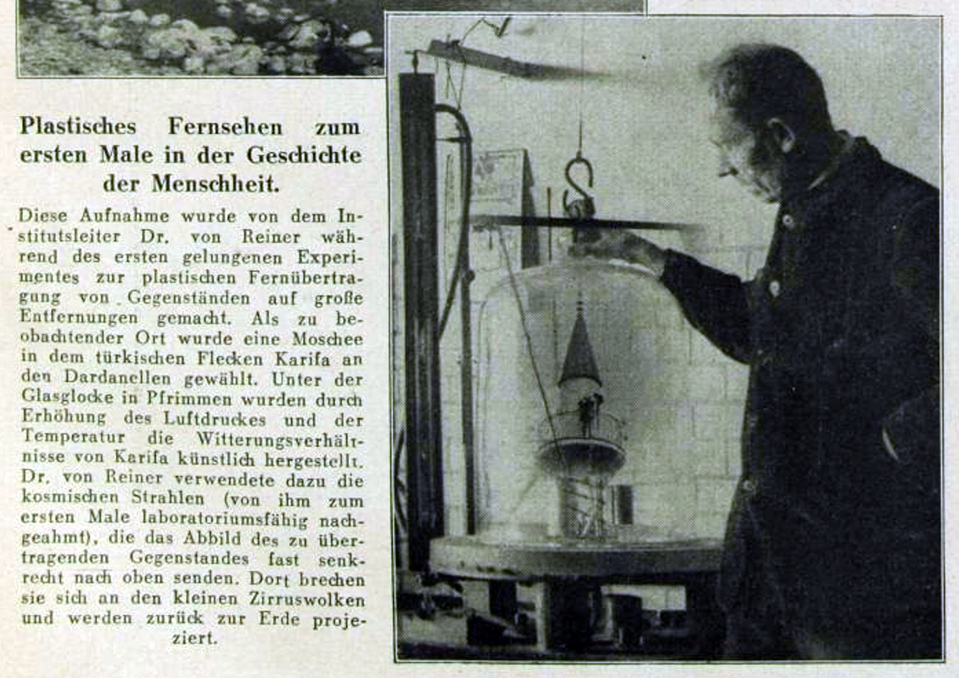
A satirical image of “plastic television for the first time in the history of humanity.” The accompanying text describes related experiments conducted by the fictitious “Central Institute for Transmitting Sonic and Aerial Images.” Here, the imaginary director of the institute, Dr. Von Reiner, supervises the transmission of a Turkish mosque from the Dardanelles to a glass dome in the German laboratory via “cosmic rays.”
Source: “Fata Morgana Im Laboratorium.” Revue Des Monats 7, no. 6 (April 1933): 549.
The experimental nature of the medium is particularly evident in representations of televisual machines in early trick films, which remain a neglected source for studying the imagination of media across traditional boundaries. While the depiction of screens within screens in the cinema of attractions is commonly taken as an allegory of cinema, I would argue that the uncanny presentation of distant objects speaks more to the ideal of telepresence, which would become even more evident in later satires of “plastic television,” i.e., teleportation. In both cases, the attempt to visualize remote projection often blurred the boundaries between transmission technologies and exhibition practices, thereby providing a reminder of the intermediate stage between production and reception, the two main poles of film studies, namely, distribution. Far more than a matter of licensing, distribution is a physical step, usually invisible or intangible in and of itself, an answer to the question, already formulated in Nipkow’s patent, of how to make “an object located at point ‘A’ visible at any other point ‘B’.”[20] Significantly, the imagination of distribution that emerged in the cinema of attractions period came at a moment when there was still a lack of concrete distribution networks, making an infrastructure modeled on wired or wireless networks seem a viable solution.[21]
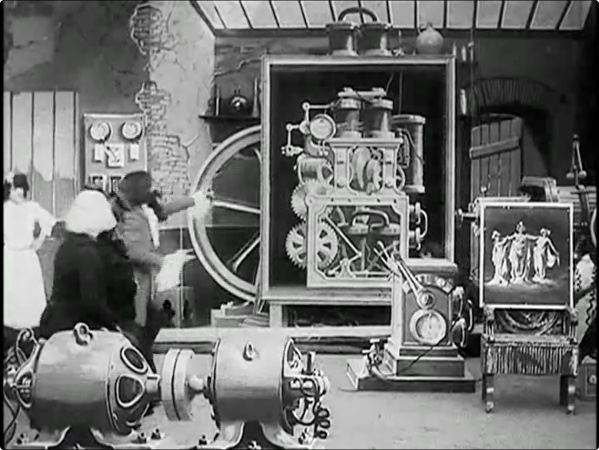
The televisual machine in Méliès’ La Photographie électrique à la distance (Long Distance Wireless Photography, 1908).
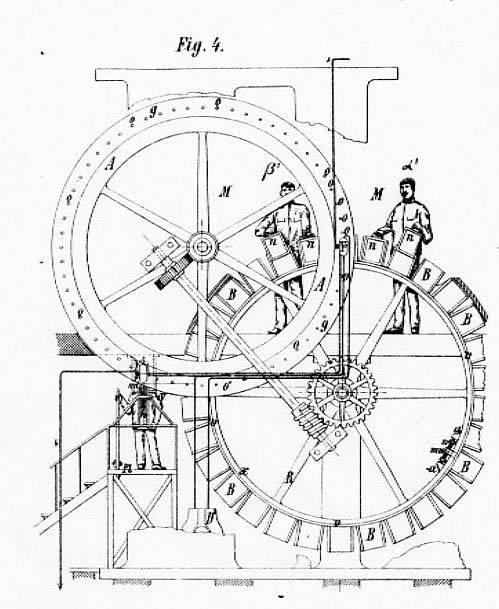
A detail from Benedict Schöffler’s booklet Die Phototelegraphie und das Elektrische Fernsehen (Phototelegraphy and electrical television, 1896).
Against the common definition of the scientific researcher as a masterful subject in complete control over the outcome of experimental trials, George Méliès’ La Photographie électrique à la distance (Long Distance Wireless Photography, 1908) illustrates the potential of things in a laboratory to spiral quickly out of control. In the celebrated short film, an elderly couple visits a telephotographer, played by Méliès, in the hopes of having their portraits taken. While the massive televisual apparatus depicted in the film strikes many commentators as fanciful, I would point out that the construction resembles several patented televisual systems, making the stakes of the experiment more relevant to original audiences.[22] As in Méliès’ film, Benedict Schöffler’s televisual devices used a camera obscura and a giant wheel equipped with photo cells inside a photographer’s atelier. After the machine is switched on, there are two experimental trials in Méliès’ film: the source of the first is a still photograph of the Charites, which suddenly comes to life; and that of the second is a live model, doubled on the screen, as her copy flirts with the elderly man, and, by extension, the audience. In this respect, the televised images speak to two competing concepts of “liveness” around 1900: temporal simultaneity in the sense of “live transmission” and spatial storage in the sense of “living images.”[23]
Despite the success of the initial trials in Méliès’ film, when the time comes for the elderly couple to have their own portraits taken, the woman’s face, presented in close-up on the TV screen, suddenly bursts out into uncontrollable laughter, which turns out to be contagious for everyone in the room; the man’s face, in turn, transforms into a monkey, and, upon discovering his alter ego, the subject of the portrait destroys the machine in a bout of rage before electrocuting himself. In my analysis, these televisual experiments gone wrong speak to the uncertainty about cinema’s place within a longer tradition of moving images. While the cinema was often presented discursively as the rightful heir to the camera obscura, this darkened chamber involved many assumptions about the fixed subject, simultaneity, spatial proximity, and the optical congruity of on-screen and off-screen worlds. Early cinematic practice, by contrast, repeatedly broke with the camera obscura tradition in its activation of multiple subject positions and points-of-view through the development of montage.[24] In subsequent years, a dramatic conflict between inventors of televisual devices and a society with greater machinations would also provide the plot device of the short films Amour et science (Love and science, 1912), Il raggio meraviglioso (The wonderful rays, 1913), and Denn die Elemente hassen (For, the elements hate, 1913). If traditional theories of knowledge tend to reduce the experiment to a matter of “prediction” and “testing,” these films resonate with more recent work in historical epistemology challenging the tyranny of the subject and his presumed mastery over the experiment, showing that “the future is in the experiment, and experimenting is about handling and engaging.”[25]
While the cinema of attractions attempted to make visible what happens during the transmission of images and objects from point A to point B, short-form modernist fiction negotiated the implications of television for political discourse, erotic communication, and, above all, the physical limits of the human body. One of the most influential literary treatments of television, Albert Robida’s imagination of a téléphonoscope, would be extended to a multi-sensory device in Camille Flammarion’s La fin du monde (The End of the World, 1894): “not only could one hear or see at a distance: the brainpower of man had even managed to transmit by cerebral influences the sensation of touch as well as that of the olfactory nerve.”[26] Developing the implications of the theme in a short story about “La toucher à distance” (Remote Projection, 1910), Guillaume Apollinaire imagined “research in wired and wireless telegraphy, the transmission of photographs, color photography and photography in relief, cinematography, the phonograph, and so on.” [27] Over the course of the story, this research enables the experimenter, a false messiah, to transmit himself simultaneously to multiple locations around the globe, though it also spells his demise when the narrator fires a bullet into one of the devices. In similar fashion, Salomo Friedländer, writing under the pen name Mynona (the German word for “anonymous” spelled backward), took the common understanding media as “extensions of man” ad absurdum in the early grotesque, “Idee vom Ferntaster” (Idea for a teletoucher, 1913). Seeing as the wireless transmission of audiovisual data involves invisible waves in the electromagnetic spectrum, Mynona reasons, then it should be possible for haptic vibrations to propagate in the same manner as light waves.[28] Developed further in Graue Magie: Ein Berliner Nachschlüsselroman (Grey magic: A Berlin-based roman à clef, 1922), the plot of which ostensibly concerns an everyman who becomes an unwitting action hero when a studio head starts filming him without his knowledge, another imaginary device described in Mynona’s novel speaks to a desire for telepresence, as an updated form of the mythic cloak of invisibility not only camouflages its bearer from detection, but also grants an unheard-of freedom of movement around the city.
In the mid-1920s, the scientific facts of television increasingly caught up with depictions of the medium in science fiction, as the popular press reported on successful experiments in 1925, including the first public demonstrations of television by John Logie Baird in England and similar experiments shortly thereafter by August Karolus in Germany. From this point on, the intermedial promise of television seemed to lie increasingly in a combination of film and radio, whether in the form of transmitting sounds into movie theaters or broadcasting moving images into the home. “We can expect to see films distributed via radio in the near future,” Rudolf Arnheim would predict in 1932, though “it would be pointless to use radio for broadcasting complete films.”[29] From the perspective of reception, on the other hand, S. E. Bastian had imagined another synthesis of film and radio in 1925: “Perhaps the telefilm will no longer even be a film. It will certainly not be a flickering strip that rolls through a black box, its little images enlarged and projected onto a screen in an auditorium. It will become simpler or more complicated, but in any case, a completely different construction.”[30] The imagined construction, consisting of “a light antenna [that] will capture the images and transmit them to the glass screen on one’s desk,”[31] bears a striking resemblance to the televisual device in Fritz Lang’s Metropolis (1927), a symbol of mastery, surveillance, and control. In addition to the novel form of the apparatus, Bastian’s telefilm also differs from both film and radio in terms of interactivity: his first predicted application of the medium is a political vision of a parliament session where “spectators can express our approval when a speaker says something that we like—or the other way around”; his second is an erotic vision of something between online dating and mail-order brides where “the telefilm would be more likely to increase the number of heartbreaks.”[32] Unlike many predictions about the emergence of television spelling the death of cinema due to inevitable media competition,[33] however, Bastian’s article on the “telecinema” concludes that “our good old film will live on,” though with a different, unpredictable function.[34]
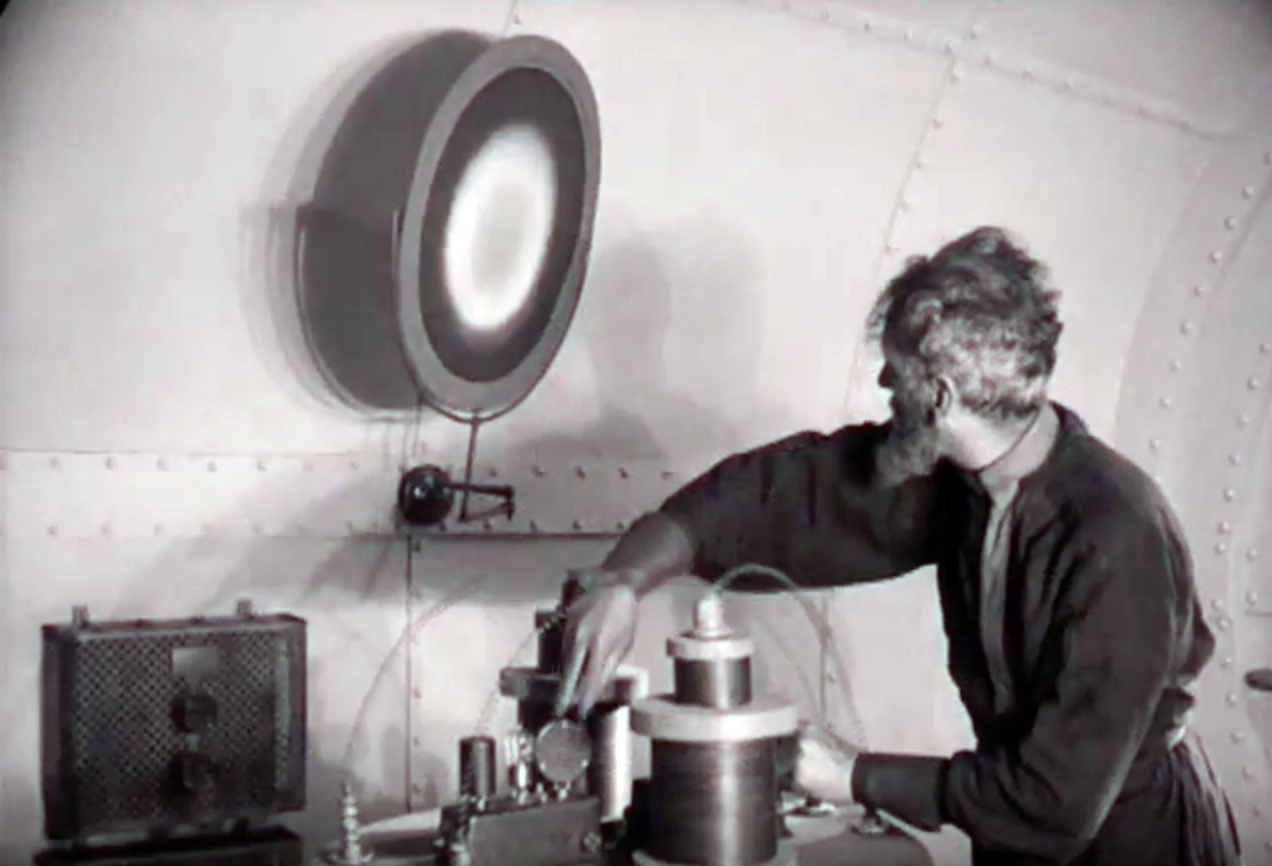
A demonstration of television in the service of explaining the popular physics of relativity, in Hanns Walter Kornblum’s Wunder der Schöpfung (Our Heavenly Bodies, 1926).
As the ontological question of television came to the center of debates about the potential convergence of film and radio, the epistemological tension between the scientific experiment and the televisual imagination also came increasingly to a head, as is particularly evident in Hanns Walter Kornblum’s Kulturfilm Wunder der Schöpfung (Our Heavenly Bodies, 1925). In an extended sequence featuring a space shuttle traveling to the ends of the known universe, the imagery and intertitles comment not only on the limits of then-current astrophysical knowledge, but also on an aporia in the discourse of television, which had developed out of anthropocentric expectations of liveness, immediacy, and telepresence. Following a striking cosmic zoom, the crew wonders, at a distance of 95 billion kilometers from the earth, “What’s it look like there?,” and gather around a circular television screen connected to their home planet. Unfortunately, the only thing on television at the moment is a Western, which, one of the crewmembers complains, is “already ten years old.” As an intertitle explains, the time-delay is due not to recording but to transmission—the ten years it takes for a single ray of light to cross the distance to the receiver relative to the source of transmission. As the spaceship accelerates to the speed of light, the televised images play in reverse: A cowboy, who has fallen off his horse, pops back in the saddle and moseys off into the horizon, trotting backward the whole time. As further illustration of these popular physics of relativity, a second TV show appears, a “live” broadcast of Moses receiving the Ten Commandments that the audience on the spaceship receives in “real-time” due to their speed relative to the earth. Still accelerating, the shuttle ultimately leaves the milky way and enters the void before the intertitles comment: “There are limits here for even the most daring imagination, so turn back!”
In subsequent years, the discrepancy between the growing expectations for television and the increasingly insurmountable technical difficulties of mechanical television systems, often served, pars pro toto, as grounds for dismissing predictions about the realization of television as such. From 1925 to 1928, the future tense commonly used in the title of popular articles about the promise of television increasingly gave way, especially in Austrian satires of the German discourse, to a present interrogative, e.g., “What’s going on with television,” which remained yet another of the “inventions we’re waiting for.”[35] In the meantime, an experimental form of television technology was presented to the public in Germany for the first time at the Funkausstellung of 1928, and the German Post Office started conducting experimental trials in the transmission of still images over radio frequencies on March 9, 1929. Even though none of these intermediate systems was quite what the majority wanted in “actual television,” the discourse of television gradually came to focus on the presumed longevity of the still-emergent project. While there was a widespread anxiety about introducing an immature technology too quickly, which would lead to a failure in its marketing, the implications of the new medium seemed so significant that its technical difficulties were often declared to be of secondary importance.
With proto-TV sets only starting to come on the market, the domestic implications of televisual technology were already an urgent concern, as is evident in Ernst Steffen’s essay on “Das Ferkino im Haus” (Telecinema in the Home, 1929). “Things we once had to go in search of are now coming to us in our homes,” Steffen reminds readers of Daheim, an illustrated magazine for families.[36] While the radio was commonly celebrated for its ability to overcome borders, the promise of radio as a medium for bringing the world into the home also contained the threat of welcoming in uninvited guests. Pursuing this line of thought to its logical conclusion, Steffen reflects that “those who now hurry to the television in their pajamas when their sleep has been disturbed, will be upset by this invention, because they will have to get properly dressed with coat and tie in order to make a good impression.”[37] In fact, the members of the educated classes would usually get dressed for listening to a radio concert in the 1920s, and television screens were still commonly covered in the 1950s when women were changing clothing.[38] Already around 1930, this reverse fantasy of television, the ability to be seen at a distance, was a common target of satire, as evident in a series of illustrations depicting “the dark side of a new invention.” “Surely technology, in its wisdom and foresight, will bring devices that allow us to turn off the picture when we see fit,” Steffen would counter,[39] adopting a rhetoric of technological solutionism resonating with more recent developments in Silicon Valley, which are even more prescient for our always-on, always-monitoring devices.
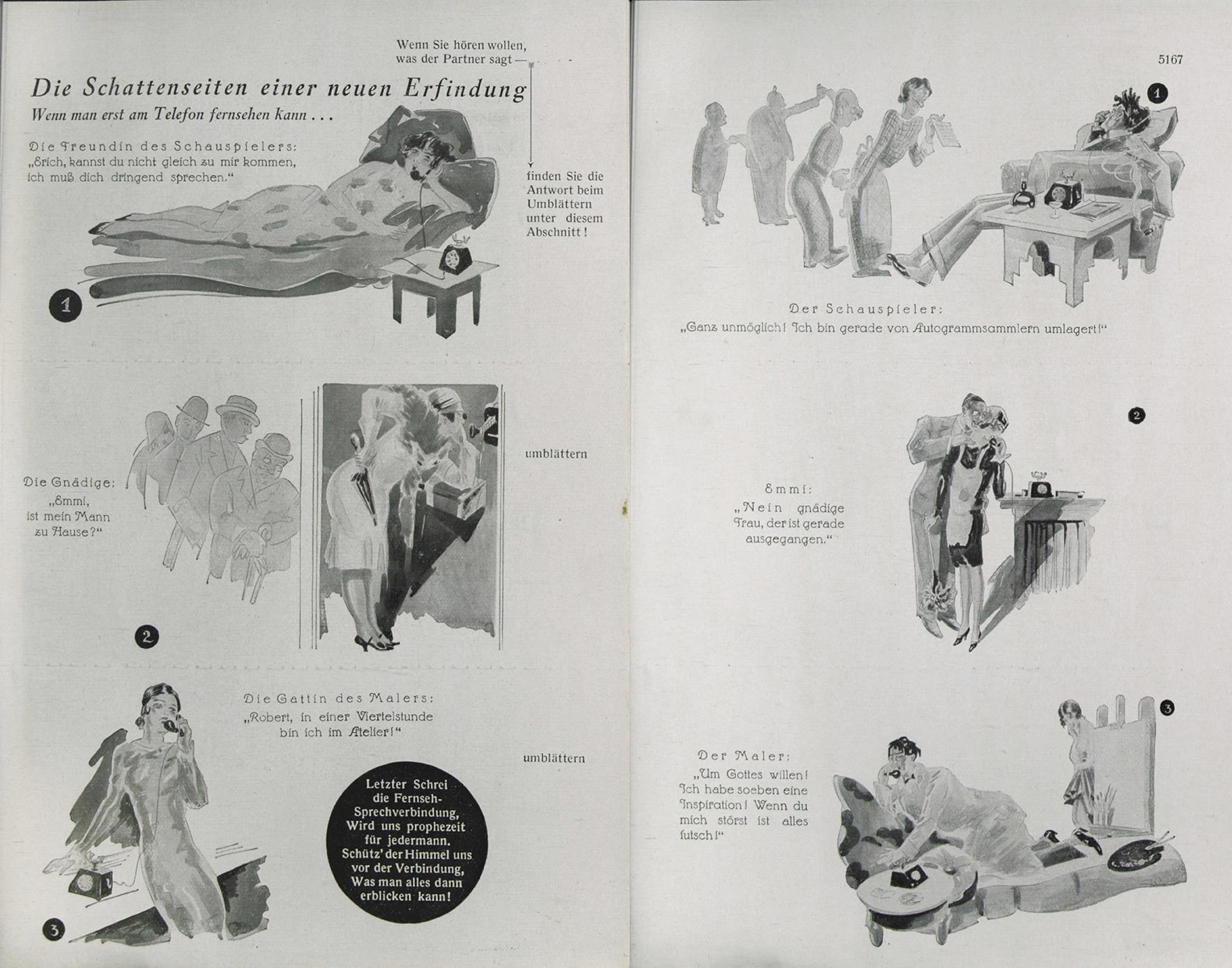
Jealousy, intrigue, and affairs are “the dark side of a new invention.” Imagining the implications of being able to be seen by television, the illustrator proclaims, “God protect us from connection, all the things we could catch sight of then!” Source: “Die Schattenseiten einer neuen Erfindung: Wenn man erst am Telefon fernsehen kann…” Das Magazin 73 (September 1930): 5165, 5167.
Behind the rhetoric of inevitable progress, there were several apparent obstacles to the realization of “telecinema in the home,” including the availability of a simple, inexpensive, and easy-to-use receiver; an image resolution that would be good enough to compete with the high standard of celluloid film; and the ability to transmit both images and sounds on the same frequency. When Arthur Korn, one of the pioneering contributors to televisual media, examined the question of “Why We Still Do Not Have Television” in 1929, he attributed the reasons not to a lack of desire but rather the implementation of technological advances. “It is a long way from technological capacity to practically viable methods,” Korn reminded those getting impatient with delays, “and it is good to push back against the grand illusions that are sometimes nourished by publicity articles, because disappointments can lead to backlash, damaging the thriving technological development of image telegraphy,” or Bildfunk.[40] For those awaiting actual television, this intermediate system, an experimental transmission of still images on the same frequency as radio broadcasts, was often considered a consolation prize. To most of the potential audience, who could not afford an expensive televisual receiver, the sonification of signals containing images, after passing through their conventional radios, resulted in pure noise. Even though image telegraphy was one of the first attempts in Germany to create an infrastructure for television, the medium was still not conceived of in the form of its own independent program, but rather as a supplement to radio, a sort of “Drahtlose Illustrierte.” To the extent that the radio, as an acoustic medium, was viewed as a transitional stage before the addition of a desired visual component, silent cinema, as a visual medium, was thought to lack an acoustic component.[41]
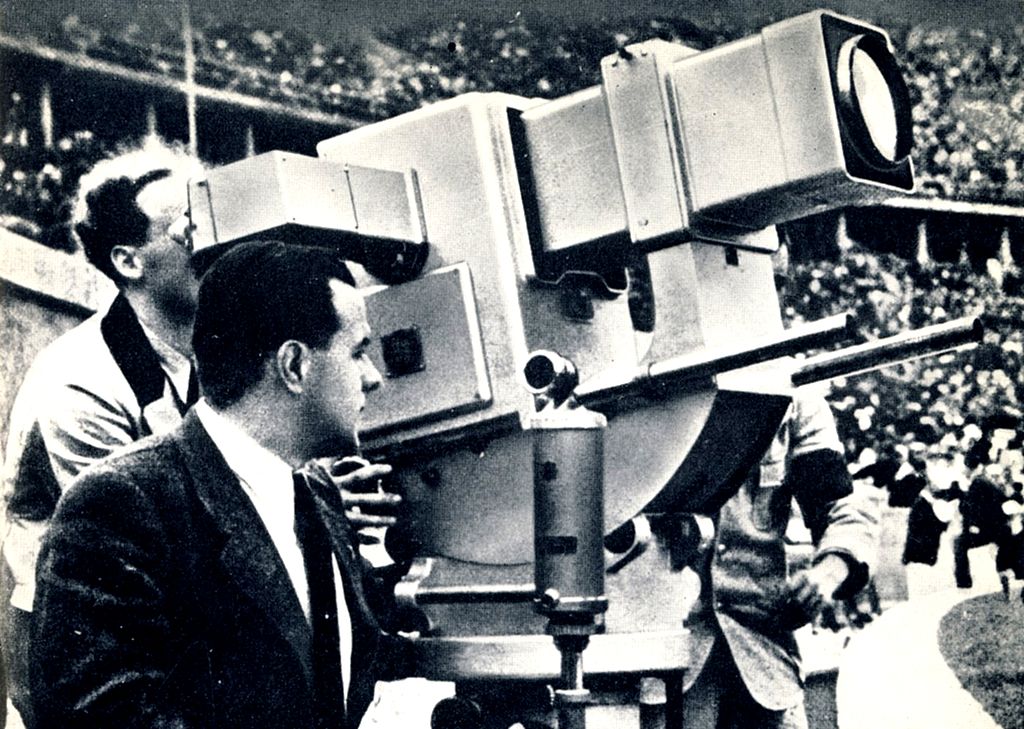
At the 1936 Summer Olympics, cameraman Walter Bruch takes aim with the “Olympia-Kanone.”
Source: Telefunken-Bild / WikiCommons
One of the most spectacular experimental trials of television came about with the Fascist choreography of the 1936 Summer Olympics, which was intended to demonstrate not only their professed supremacy of the Aryan race, but also the ostensible superiority of German television technology.[42] On the Reichssportfeld, there were a total of five different televisual devices for recording images, another indication of the experimental status of televisual systems at various stages of completion. The most developed system, the Fernseh AG’s intermediate film system, was composed of mechanical-optical devices, an outgrowth of Nipkow’s patent relying on a mechanical disk for scanning. Using a roof-mounted camera, exposed film would be dropped down into a broadcast van where it could then be processed, scanned, and projected as a TV signal. The other main competitor, Telefunken’s fully electric system, produced an immediate signal, more like what would develop after World War II and dominate the pre-digital area.[43] To broadcast the Games of the XIth Olympiad, the TV station based out of Berlin-Witzleben, Deutscher Fernseh-Rundfunk, which had recently been renamed the “Paul Nipkow” Station in a problematic gesture, made direct transmissions from the sports venues in Berlin to 27 television parlors, which had been created explicitly for that purpose in Berlin and Potsdam, as well as to a small number of private television owners. In contrast to the USA and England, which tended to promote home viewing, the Fascist regime in Germany promoted collective reception, which was supposed to take on a surrogate function for physical participation in mass assemblies.[44] Overall, the limited television coverage of the Olympic Games was considered a success, insofar as the recording, transmission, and storage devices all worked according to plan, though the main disadvantage of direct transmission, which still depended on the same conditions of a laboratory, was that the coverage could only be followed in the immediate vicinity.
While the original audience for Nazi Germany’s television coverage of the Olympics remained limited, the powerful wireless broadcast signal, one of the first conducted at a high enough frequency to break through the ionosphere, which otherwise acts as a planetary “filter bubble,” preventing most radio and television broadcasts from escaping the atmosphere, finds an unexpected recipient in Carl Sagan’s Contact. Originally drafted as a screenplay in 1979, completed as a novel in 1985, and made into a film in 1997, the three-part narrative offers a cosmic version of information theory—“The Message,” “The Message,” and “The Galaxy.” One of the most memorable moments in the story, which was composed while Sagan was employed as a professor of astronomy at Cornell University and an advisor to NASA, comes when a team working for the SETI program decode an interstellar transmission containing a sequence of prime numbers, revealing audio-visual information contained within the polarization modulation of the signal.[45] To their surprise, the message is not a response to any of the carefully-planned interstellar transmissions of the 1970s, many of which Sagan helped design, but rather a retransmission of a historical terrestrial broadcast, revealed following a dramatic close-up of a swastika to be footage of Adolf Hitler at the opening ceremony of the Olympic Games. Upon closer inspection, however, the rebroadcast signal is shown to contain additional blueprints for a machine for interstellar space travel, and when, after multiple experimental trials, the promised interspecies contact finally occurs, the question looms large (if not in the film at least in the novel) of why the aliens made contact using the chilling 3-minute clip of the Nazis in the first place. “Humans are very good at dreaming, although you’d never know it from your television,” the ETI counters. In the end, “The Test” for humanity on the galactic stage consists in demonstrating more “lovingkindness” than had previously been evident in their regularly scheduled programming.[46] If the promise of television consists in enabling a form of contact that can overcome space and time, the future of the medium depends on an audience who remains attuned to its historical possibilities.[47]
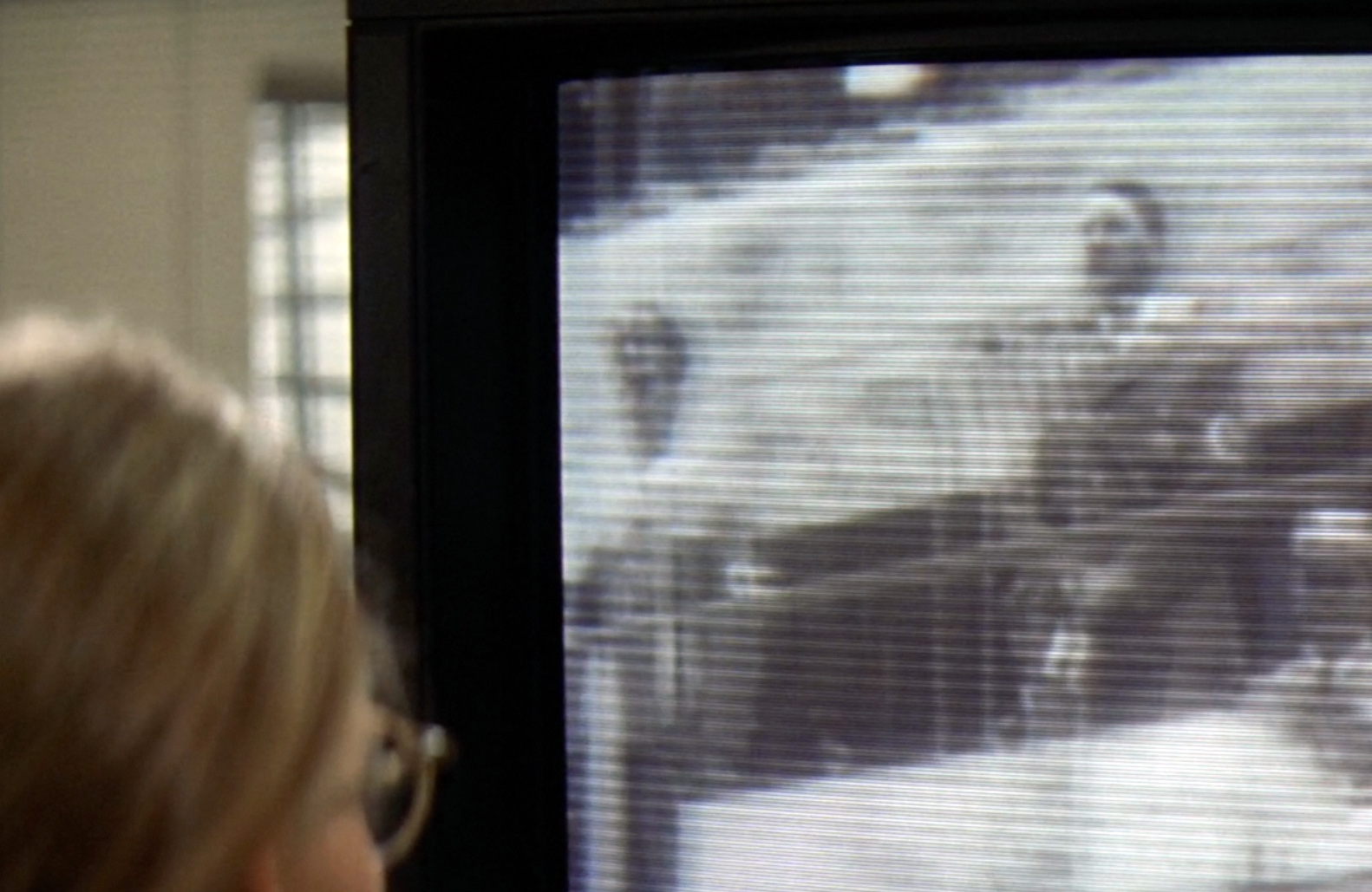
In the search for extraterrestrial intelligence, humanity makes contact, via television, with its own dark past in Carl Sagan’s novel, and later film, Contact (1985/1997).
Download this article as a PDF.
Erik Born is an Andrew W. Mellon postdoctoral fellow in the Society for the Humanities and the Department of German Studies at Cornell University. He received a concurrent PhD in German Studies and Medieval Studies with a Designated Emphasis in Film and Media Studies from the University of California, Berkeley in May 2016. His dissertation, Sparks to Signals: Literature, Science, and Wireless Technology, 1800–1930, examined the emergence of wireless media over the longue durée, from the medieval imagination of mystical communication to the modern development of radio, television, and wireless telegraphy. Developing this research, his book in progress focuses on the literary and cultural imagination of wireless media around 1900, a transitional moment, much like our own, when possibilities for future development still seemed wide open. Erik is also the co-editor of a volume on the figure of the neighbor in German modernity, and the author of articles on medieval media theory, early German science fiction, and avant-garde films, as well as translations and book reviews on topics in film and media studies. In addition to teaching German literature and culture, his recent courses using The Promise of Cinema sourcebook have addressed the “Cinema of the Weimar Republic” and the question of cinema and the digital divide under the title “What was film?”
Please cite this article as:
Born, Erik. “The Promise of Television.” The Promise of Cinema. 10-14-2017. ./index.php/the-promise-of-television/.
[1] On the following difficulties of television history, see Lorenz Engell, “Schwierigkeiten der Fernsehgeschichte [1993],” in Ausfahrt nach Babylon: Essais und Vorträge zur Kritik der Medienkultur (Weimar: Verlag und Datenback für Geisteswissenschaften, 2000), 89–107; Judith Keilbach, “Die vielen Geschichten des Fernsehens: Über einen heterogenen Gegenstand und seine Historisierung,” montage AV 14, no. 1 (2005): 29–41.
The Promise of Cinema circumvents some of the difficulties of chronological priority by starting with the year 1907. The justification for this terminus post quem is the establishment of the first German film journals, which provide many of the texts for the sourcebook. By contrast, the first German television journals only started to develop much later out of the pages of radio journals in the 1920s.
[2] See, among others, Siegfried Zielinski, Audiovisions: Cinema and Television as Entr’actes in History, trans. Gloria Custance (Amsterdam: Amsterdam University Press, 1999); Erkki Huhtamo, “Natural Magic: A Short Cultural History of Moving Images,” in The Routledge Companion to Film History, ed. William Guynn (New York: Routledge, 2011), 3–15; Thomas Elsaesser, Film History as Media Archaeology: Tracking Digital Cinema (Amsterdam: Amsterdam University Press, 2016).
[3] Larson Powell and Robert Shandley, “Introduction: German Television: Culture, Technology, or Cultural Technology?,” in German Television: Historical and Theoretical Perspectives, ed. Larson Powell and Robert Shandley (New York: Berghahn, 2016), 4.
[4] Larson Powell, “Boredom, War, and Paradox: German Theories of Television,” in German Television, 34.
[5] See, among others, Lorenz Engell, Fernsehtheorie zur Einführung (Hamburg: Junius, 2011); Marijke de Valck and Jan Teurlings, eds., After the Break: Television Theory Today (Amsterdam: Amsterdam University Press, 2013).
[6] See, for example, Kerstin Bergmann and Siegfried Zielinski, “‘Sehende Maschinen’: Einige Miniaturen zur Archäologie des Fernsehens,” in Televisionen, ed. Stefan Münker (Frankfurt am Main: Suhrkamp, 1999), 13–38; William Uricchio, “Reflections on a Forgotten Past: Early German Television as a History of Absences,” Österreichische Zeitschrift für Geschichtswissenschaften 12, no. 4 (2001): 42–59; Doron Galili, “Introduction: Early Television Historiographies,” E-Media Studies 5, no. 1 (2016).
[7] Judith Keilbach and Markus Stauff, “When Old Media Never Stopped Being New: Television’s History as an Ongoing Experiment,” in After the Break, 80.
[8] Anton Kaes, Nicholas Bear, and Michael Cowan, eds., The Promise of Cinema: German Film Theory, 1907–1933 (Berkeley: University of California Press, 2016), 1.
[9] Monika Elsner, Thomas Müller, and Peter M. Spangenberg, “The Early History of German Television: The Slow Development of a Fast Medium,” in Materialities of Communication, ed. Hans Ulrich Gumbrecht and Karl Ludwig Pfeiffer (Stanford: Stanford University Press, 1988), 107–43.
[10] See Keilbach and Stauff, “When Old Media Never Stopped Being New;” Hans-Jörg Rheinberger and Michael Schwab, “Forming and Being Informed: Hans-Jörg Rheinberger in Conversation with Michael Schwab,” in Experimental Systems: Future Knowledge in Artistic Research, ed. Michael Schwab (Leuven, 2013), 198–219.
[11] See Lorenz Engell, “Fernsehen mit Unbekannten: Überlegungen zur experimentellen Television,” in Fernsehexperimente: Stationen eines Mediums, ed. Michael Grisko and Stefan Münker (Berlin: Kadmos, 2009), 15–45.
[12] Knut Hickethier, Geschichte des deutschen Fernsehens (Stuttgart: Metzler, 1998), 9.
[13] See Heide Riedel, Fernsehen – Von der Vision zum Programm: 50 Jahre Programdienst in Deutschland (Berlin: Deutsches Rundfunk-Museum, 1985), 14.
[14] See Stefan Andriopoulos, “Psychic Television,” Critical Inquiry 31, no. 3 (Spring 2005): 618–37.
[15] See Clas Dammann, Stimme aus dem Äther, Fenster zur Welt: Die Anfänge von Radio und Fernsehen in Deutschland (Cologne: Böhlau, 2005).
[16] See Bergmann and Zielinski, “‘Sehende Maschinen.’”
[17] Friedrich Kittler, Optical Media: Berlin Lectures 1999, trans. Anthony Enns (Malden, MA: Polity Press, 2009), 207–8.
[18] Ibid., 226.
[19] See Walter Friedel, Elektrisches Fernsehen, Fernkinematographie und Bildfernübertragung (Berlin: Meusser, 1925); Peter Lertes, Fernbildtechnik und elektrisches Fernsehen (Frankfurt am Main: Bechhold, 1926); Arthur Korn, Elektrisches Fernsehen (Berlin: Salle, 1930).
[20] Paul Nipkow, Elektrisches Teleskop, Kaiserliches Patentamt 30105 (Berlin, filed January 6, 1884, and issued January 15, 1885).
[21] See Wanda Strauven, “The Imagination of Wireless Distribution,” in Networks of Entertainment: Early Film Distribution 1895–1915, ed. Frank Kessler and Nanna Verhoeff (Bloomington, IN: Indiana University Press, 2007), 296.
[22] Originally described in the 1880s as “electrical television” and demonstrated the year prior to the release of Méliès’ film by Edouard Belin in France and Arthur Korn in Germany under the names of télephotographie and Bildtelegraphie, these televisual systems more closely resemble what would later become known as “telefacsimile,” or simply “fax” machines.
[23] See William Uricchio, “Storage, Simultaneity, and the Media Technologies of Modernity,” in Allegories of Communication: Intermedial Concerns from Cinema to the Digital, ed. John Fullerton and Jan Olsson (Eastleigh: John Libbey, 2004), 123–38; Stephen Kern, The Culture of Time and Space: 1880–1918 (Cambridge, MA: Harvard University Press, 2003).
[24] See Uricchio, “Storage, Simultaneity, and the Media Technologies of Modernity.”
[25] Hans-Jörg Rheinberger and Michael Schwab, “Forming and Being Informed,” 203.
[26] Quoted in Wanda Strauven, “The Observer’s Dilemma: To Touch or Not to Touch,” in Media Archaeology: Approaches, Applications, and Implications, ed. Erkki Huhtamo and Jussi Parikka (Berkeley: University of California Press, 2011), 159.
[27] Guillaume Apollinaire, “The False Amphion, or the Stories and Adventures of Baron D’Ormesan,” in The Heresiarch and Co., trans. Rémy Inglis Hall (New York: Doubleday, 1965), 179–80.
[28] Mynona (Salomo Friedlaender), “Idee vom Ferntaster,” Der Sturm 4, no. 170–171 (July 1913): 66–67.
[29] Rudolf Arnheim, “Radio-Film,” in The Promise of Cinema, 602.
[30] S.E. Bastian, “The Telefilm,” in The Promise of Cinema, 585.
[31] Ibid.
[32] Ibid.
[33] See, for example, “Droht dem Kino vom Fernkino Gefahr?” Österreichische Film-Zeitung 10 (March 2, 1929): 4–5; “Umwertung aller Filmwerte: Fernkino und Funkfilm,” Der Kinematograph 23, no. 207 (September 5, 1929).
[34] Bastian, “The Telefilm,” 585.
[35] “Was ist’s mit dem Fernkino?,” Österreichische Film-Zeitung 26 (June 23, 1928): 23; “Erfindungen, auf die wir warten…,” Pilsner Tagblatt 228 (August 20, 1928): 3.
[36] Ernst Steffen, “Telecinema in the Home,” in The Promise of Cinema, 596.
[37] Ibid., 598.
[38] See the editors’ notes in Ernst Steffen, “Das Fernkino im Haus” [1929], in Medientheorie 1888–1933: Texte und Kommentare, ed. Albert Kümmel and Petra Löffler (Frankfurt am Main: Suhrkamp, 2002).
[39] Steffen, “Telecinema in the Home,” 598.
[40] Arthur Korn, “Why We Still Do Not Have Television: Possibilities of Electric Television,” in The Promise of Cinema, 591.
[41] See the editors’ notes in Eduard Rhein, “Wollen wir fernsehen?” [1929], in Medientheorie 1888–1933: Texte und Kommentare, ed. Albert Kümmel and Petra Löffler (Frankfurt am Main: Suhrkamp, 2002), 410.
[42] See Zielinski, Audiovisions, 170–71.
[43] See Franz Pichler, Elektrische Bilder aus der Ferne: Technische Entwicklung von Bildtelegraphie und Fernsehen bis zum Jahre 1939 – Von den mechanisch-optischen Anfängen zu den elektronischen Systemen (Linz: Universitätsverlag Rudolf Trauner, 2010), 86–88; Anne-Katrin Weber, “Recording on Film, Transmitting by Signals: The Intermediate Film System and Television’s Hybridity in the Interwar Period,” Grey Room 56 (2014): 6–33.
[44] See Elsner, Müller, and Spangenberg, “The Early History of German Television,” 130–32.
[45] Carl Sagan, Contact [1985] (New York: Simon and Schuster, 1997), 86.
[46] Ibid., 359.
[47] While the film adaptation of Contact clearly uses the famous footage filmed for a British Pathé newsreel, the novel is more circumspect about the authenticity of the broadcast: “Incidentally, we haven’t been able to find any record from German archives of what was in that original broadcast. We can’t be absolutely sure that the people of Vega haven’t made some change in the content before sending it back to us. We can recognize Hitler, all right, and the part of the Olympic stadium we see corresponds accurately to Berlin in 1936. But if at that moment Hitler had really been scratching his mustache instead of smiling as in that transmission, we’d have no way to know.” (100)